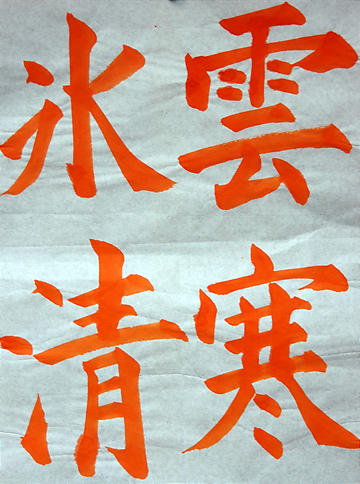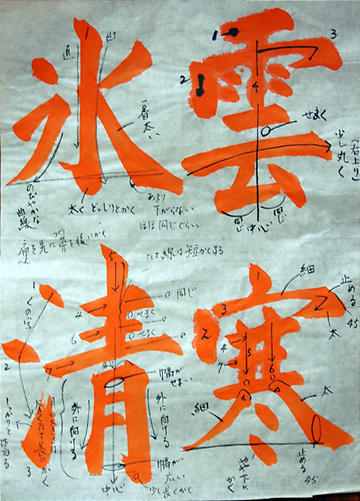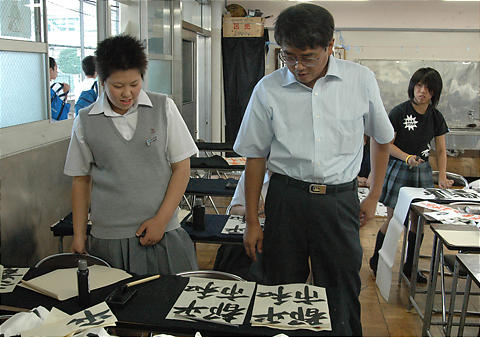December 21, 2006
Calligraphy 101



Unkan Hyousei is a winter expression meaning 'the clouds are cold and the ice is clean', written by Murou Sensei, seen above with a visiting junior high school student.
Every civilization has a system of beautiful calligraphic practice, and in Japan it is called ‘shodo’. Here at Seiritsu, we have our own special shodo room, and more importantly, our own resident shodo master, Maruo Osamu Sensei. For 30 years, Maruo Sensei (who goes by Maruo Renshi in the shodo world) has guided the writing hands of our students, while he himself has become a renowned calligrapher, displaying his work often at galleries and calligraphy events, adjudicating competitions and sometimes producing pieces for the Mainichi Shinbun (‘Everyday Newspaper’), one of the largest newspapers in Japan.
The Japanese written language is partly made up of Chinese characters imported around 500AD, in Japanese called ‘kanji’. The other parts of the Japanese writing system, the separate hiragana and katakana syllabary scripts, are also derived from kanji. So when anything is written with a brush and ink on paper, it becomes shodo. To understand the art of shodo, one must first have a simple understanding of kanji.
Kanji are Chinese writing logograms, used to visually represent a meaning, similar to numbers. Kanji are normally pared up with other kanji or Japanese syllabary script to make words and individual kanji can be quite complex being made up of several kanji shrunken and put together, or common kanji elements combined.
There are 1945 individual ‘common kanji’ (jyoyo) taught to students, each school grade from elementary school to high school learning a certain set amount. Regular day use of kanji requires probably between 2000-3000 when technical kanji and odd kanji used for some personal names are counted. While there are said to be some 50,000+ kanji in Chinese, the maximum tested at the highest level of the Kanji Kentei (official) test in Japan is 6000. Of course, tens of thousands of words are made when individual kanji are paired together.
Japan inherited the different styles of shodo from China as well, and even today from a young age Japanese are taught to write with a brush. In the shodo world, there are block styles for engraved seals, square styles for printing, semi-cursive styles for ease of writing and cursive styles that can actually be almost unreadable.
Definitely shodo is an art form that has many variations, sometimes even avant-garde, and there are some ancient, profound guidelines to follow when writing, but here are some academic examples of the basics; the proper way one must hold the brush is upright, one must alignment the center of their body to the paper to provide balance, when writing attempt to create a right-side rising slope, try to fit all kanji into an imaginary pentagon shape, and make sure to keep the top and bottom of each kanji proportional to each other. The finished product is said to portray the writer’s awareness to what they are doing, a snapshot of their spirit at that moment, revealing their confidence, or lack of it, and of course the level of their overall skill.
There are many shodo associations in Japan which offer monthly grade tests. Also here at Seiritsu, we have a shodo club, carefully watched over by Maruo Sensei, so keep an eye on this space for a shodo club posting soon.
The two scanned pages are Maruo Sensei’s samples for what I have to practice this month. I thought the second one with all the notes explaining the proper shodo basics one must know to be quite visually interesting. Those little memos scattered all over the sheet state things like ‘thick line’, ‘thin line’, ‘rise to the right’, ‘this space small’, ‘this space same as above’, etc, with the numbers signifying the stroke orders.
As for now, I will tell you my favorite moment when I have my shodo lesson once a week with Maruo Sensei. For one month I only practice a short phrase over and over, one sheet at a time, and each time I finish a sheet Maruo Sensei corrects it with red ink and then I try again. Well, the part I enjoy the most, other than being finally told I’ve ‘nailed’ it (which is not often) and that I can move on to the next phrase, are those times when he praises me for what I thought he would for sure say is a mistake. In those very rare moments, he explains it is obvious I was very conscious of the stroke when I made it. One with the brush, or simple luck, well, only time will tell.
If you visit our school, inevitability Maruo Sensei will whisk you off to the shodo room to let you try making your own characters with a brush, even if you’ve never studied Japanese before. The results are always interesting, and you get to take home a unique souvenir…
RM